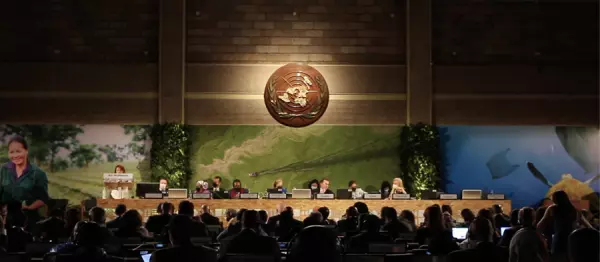UNEA is an initiator or catalyst. It starts negotiations for new treaties or bodies, but it doesn’t finish these negotiations. It identifies emerging issues and (hopefully) agrees to the next steps needed to start learning about and addressing these issues.
It is also a coordinator. It oversees the work of the UN Environment Programme. It was created in 2012, during the Rio+20 negotiations, with the objective of strengthening and upgrading UNEP. In less than ten years, UNEA has become a central body to identify, prioritize, and coordinate global responses to environmental issues. UNEA was born into a world already full of environmental treaties and bodies, each with their own mandate. In its initiator and coordinator roles, it has to carefully consider existing mandates and avoid adding to the already overlapping sets of rules. While doing this, UNEA has also emerged as a body that can help clarify where those overlaps lay, as a first step to coordinating environmental governance more widely, beyond UNEP.
UNEA at Work
UNEA negotiations are unlike talks at any other environmental body. Delegates at UNEA meetings do not negotiate new treaties. Instead, country representatives put forward resolutions. Sometimes, multiple countries put forward a resolution on the same issue. These resolutions outline the nature of the problem and potential solutions, as the proponents see it.
Immediately before UNEA, the Open-Ended Committee of Permanent Representatives (OECPR) meets to debate these resolutions. By this time, proponents have often worked together to merge multiple resolutions into one, joint resolution. Negotiators then refine – or rework – the ideas and text in those resolutions.
After OECPR, UNEA convenes. Ideally, the OECPR has forwarded a clean, agreed text. But there are times when outstanding issues require the attention of higher-level UNEA delegates. UNEA members further discuss these resolutions and the Ministerial Declaration. High-level speeches help to signal common interests and priorities. Finally, the resolutions are (usually) adopted.
Yes, No, Or Keep Talking
Some resolutions do not succeed. For example, India and supporters failed to realize a clear call at UNEA-4 to phase out single- use plastics (although the Ministerial Declaration calls for a phase out by 2030). In 2019, Switzerland ultimately withdrew its proposed resolution on geoengineering . There were questions about what technologies count as “geoengineering.” Some countries objected to veering into climate issues, because there are established bodies and rules for reducing emissions and building resilience to climate change. Others argued that UNEP should get ahead of the geoengineering experiments and assess the potential benefits and drawbacks of these technologies before they are widely deployed.
Some resolutions are passed and lead directly to implementation actions. This route tends to happen under two scenarios. First, when there are established bodies in place to take up further actions. UNEA identifies additional actions and sends an important signal on the need to do more. The resolution on nitrogen management , for example, highlights the linkages to a range of issues, including climate change, and identifies organizations that could better coordinate, including the Food and Agriculture Organization that is outside UNEP.
Second, when parties struggle to reach agreement on the mandate for further work, a resolution may be adopted that asks the UNEP Executive Director to work with existing institutions or regions to strengthen a response. For example, UNEA-3 struggled with the scope of a resolution on air quality first proposed by Canada and the African Group. Some preferred to discuss regional or even local level impacts of air quality, while others wanted to stress the transboundary and global effects of air pollution. The resolution calls for member states to consider joining regional and global initiatives, and for the UNEP Executive Director to look into how to strengthen these efforts.
Other resolutions trigger a progression of work, particularly when there is a gap in global governance. Marine plastics is a prime example. Since 2014, the issue progressed from identification as a global threat to a proposal to begin negotiations for a global treaty. Since then, the Basel Convention , which regulates the transboundary movement of hazardous wastes, adopted a decision on plastics. Shipments of certain plastics now require the prior informed consent of the importing country. At the same time, there was a growing consensus in the Ad Hoc Open-Ended Expert Working Group on marine litter established by UNEA that a global treaty might be necessary.
The resumed, in-person UNEA-5 meeting will consider establishing negotiations for a marine plastics treaty and will likely hotly debate its scope. The evolution from agreeing that marine plastics pose a global threat to the environment and health to debating if a formal treaty is necessary has not been easy. There was pushback against establishing the Working Group at UNEA-4, and its role was scaled back to a stocktake of existing efforts and consideration of options.
Tags: UNEA's Role as Governance Architect



